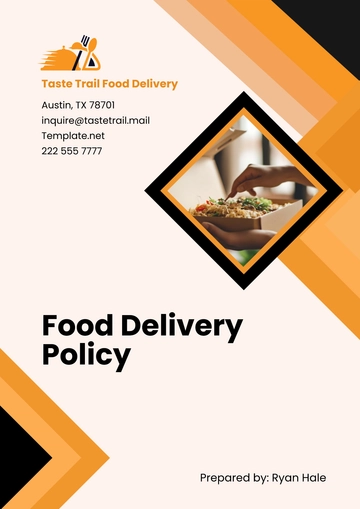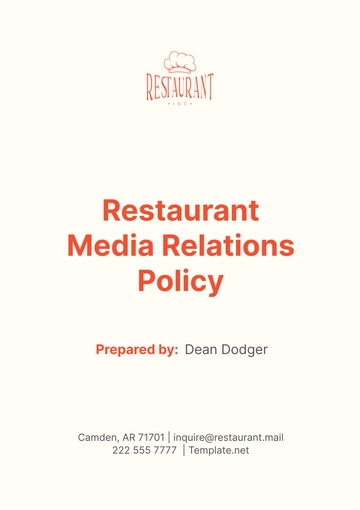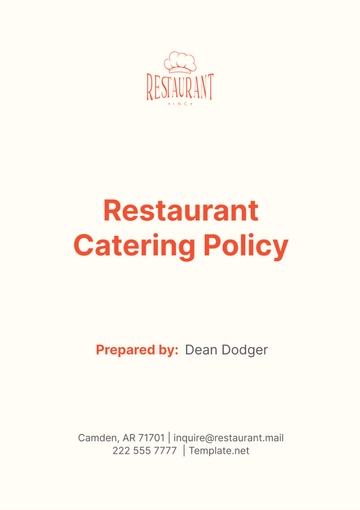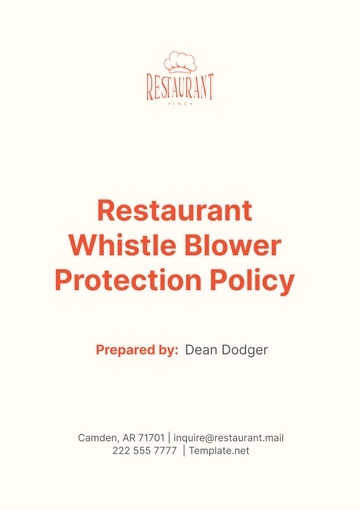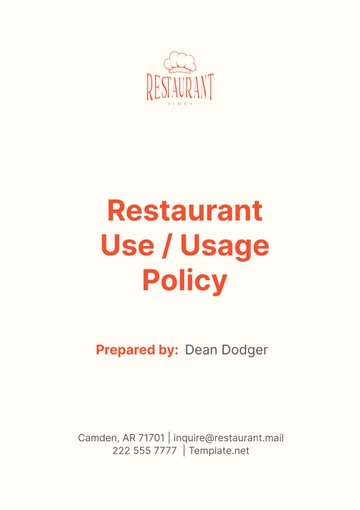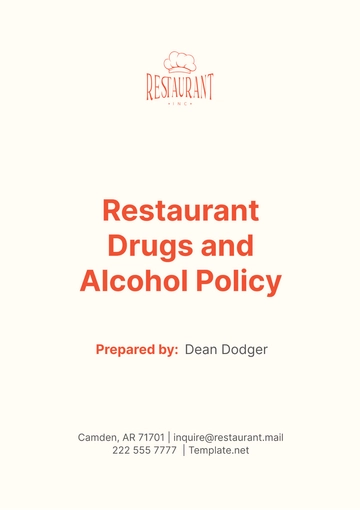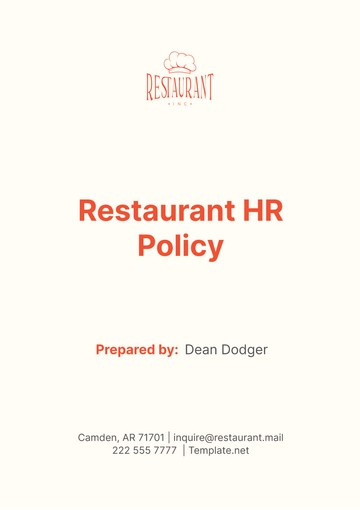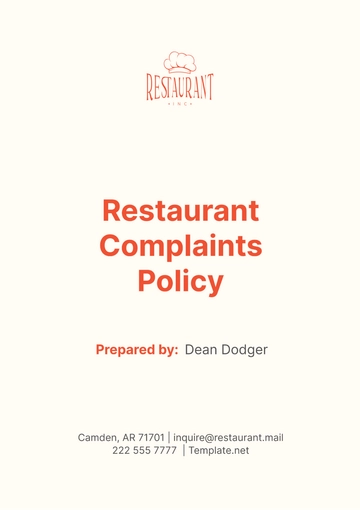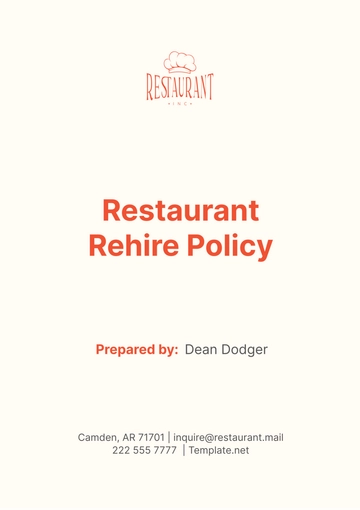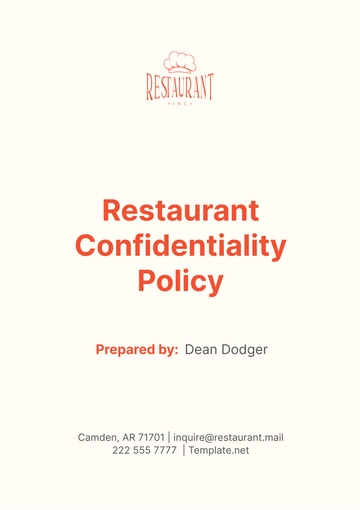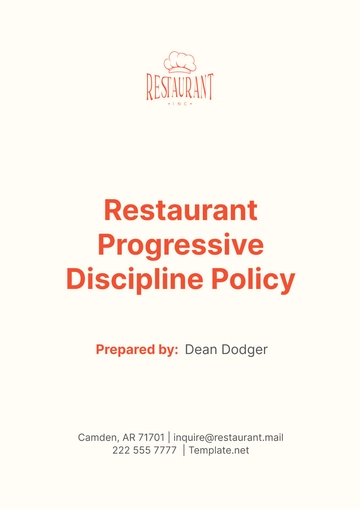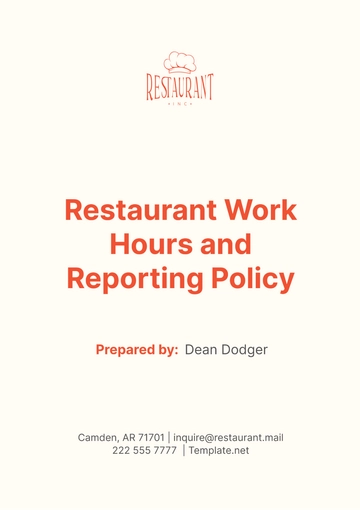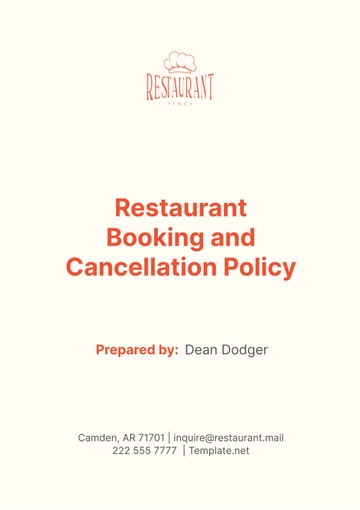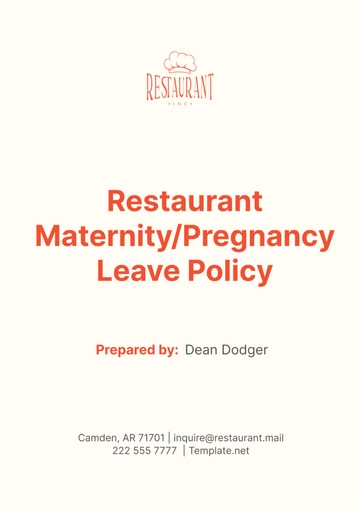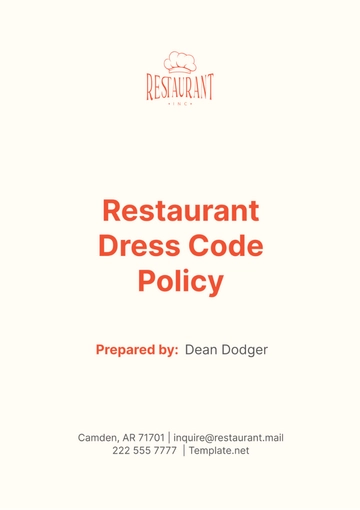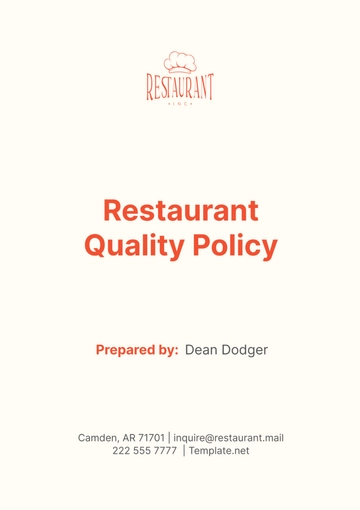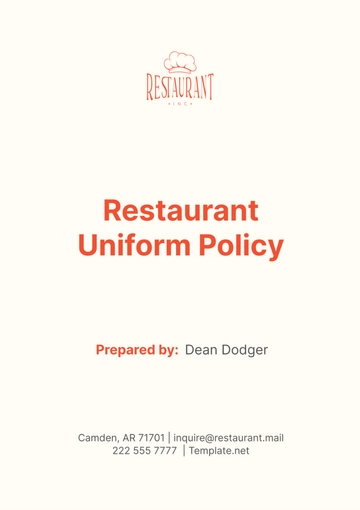Free Restaurant Financial Policy
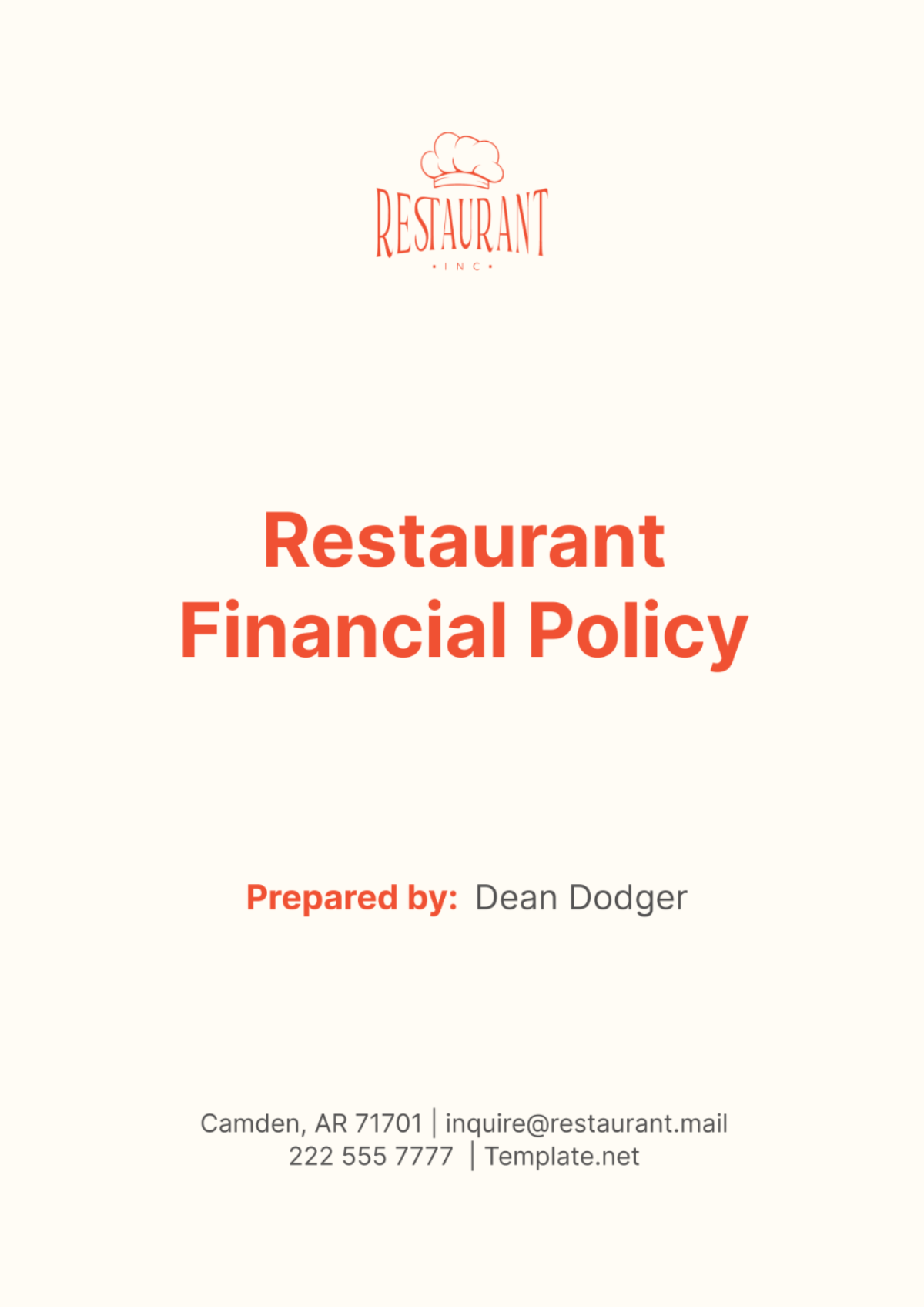
I. Introduction
A. Purpose of the Policy
The Restaurant Financial Policy outlines the principles and procedures governing the financial management of [Your Company Name]. Its primary purpose is to ensure the prudent and effective utilization of financial resources, maintain financial integrity, and support the long-term sustainability of the business.
B. Scope and Applicability
This policy applies to all employees, managers, and stakeholders involved in financial activities at [Your Company Name]. It encompasses budgeting, accounting practices, revenue management, cost control measures, financial reporting, and compliance with regulatory requirements.
C. Key Objectives
To establish clear financial goals and objectives for [Your Company Name].
To maintain accurate financial records and ensure compliance with accounting standards.
To optimize revenue generation and profitability through effective pricing and cost management strategies.
To promote transparency, accountability, and ethical conduct in financial operations.
To mitigate financial risks and ensure regulatory compliance.
II. Budgeting and Financial Planning
A. Establishing Financial Goals
The financial goals of [Your Company Name] include achieving a targeted annual revenue growth rate of [0]%, maintaining a food cost percentage of [0]% or lower, and achieving a net profit margin of [0]%.
B. Annual Budget Preparation Process
The annual budget will be prepared by the management team in collaboration with department heads. It will include projected revenues, expenses, and capital expenditures for the upcoming fiscal year, based on historical performance, market trends, and business objectives.
C. Budget Allocation for Key Expenses
Food and Beverage Costs: Budget allocation for food and beverage purchases will be based on projected sales volume, menu pricing, and cost control measures to maintain a targeted food cost percentage.
Labor Costs: Budget allocation for labor expenses will consider staffing requirements, wage rates, and productivity targets to optimize labor utilization while controlling payroll costs.
Overhead Expenses: Budget allocation for overhead expenses such as rent, utilities, insurance, and maintenance will be based on historical expenditure patterns and anticipated changes in operating conditions.
Marketing and Promotion Budget: Budget allocation for marketing and promotional activities will be determined based on marketing objectives, target audience, and expected return on investment (ROI).
III. Accounting Practices
A. Recording Financial Transactions
All financial transactions will be promptly recorded in the accounting system following generally accepted accounting principles (GAAP). This includes sales revenue, expenses, inventory purchases, payroll transactions, and capital expenditures.
B. Chart of Accounts
The chart of accounts will be maintained to accurately categorize financial transactions and facilitate financial reporting and analysis. It will be periodically reviewed and updated to reflect changes in business operations.
C. Financial Reporting Schedule
Monthly financial statements will be prepared and distributed to management, including income statement, balance sheet, and cash flow statement. Additional ad hoc reports may be generated as needed to support decision-making and monitoring of financial performance.
D. Compliance with Accounting Standards
[Your Company Name] is committed to maintaining compliance with relevant accounting standards, including International Financial Reporting Standards (IFRS) or Generally Accepted Accounting Principles (GAAP), as applicable.
E. Internal Controls and Audit Procedures
Internal controls will be established to safeguard assets, prevent fraud, and ensure the accuracy and reliability of financial reporting. Regular internal audits will be conducted to assess compliance with policies and procedures and identify areas for improvement.
IV. Revenue Management
A. Pricing Strategy
Menu pricing will be based on factors such as ingredient costs, competition analysis, perceived value, and customer demand. Pricing decisions will be periodically reviewed and adjusted to optimize revenue and profitability.
B. Menu Engineering and Analysis
Menu items will be evaluated based on their contribution margin, popularity, and profitability. Menu engineering techniques will be used to promote high-margin items and optimize the menu mix.
C. Sales Channel Management
[Your Company Name] will utilize various sales channels, including dine-in, takeout, delivery, and catering, to maximize revenue opportunities. Each channel will be evaluated based on its contribution to overall sales and profitability.
D. Promotion and Discount Policies
Promotional activities and discounts will be strategically implemented to attract customers, increase sales volume, and drive repeat business. Promotions will be monitored to assess their effectiveness and ROI.
V. Cost Control Measures
A. Inventory Management
Inventory levels will be monitored regularly to prevent overstocking and minimize wastage. Just-in-time inventory practices will be implemented to optimize inventory turnover and reduce carrying costs.
B. Food Waste Reduction Strategies
[Your Company Name] will implement measures to minimize food waste, such as portion control, menu engineering, and staff training on waste reduction techniques. Surplus food may be donated to charitable organizations to minimize waste.
C. Labor Utilization Optimization
Labor scheduling will be optimized based on forecasted sales volume and customer traffic patterns to ensure adequate staffing levels while minimizing labor costs. Cross-training initiatives will be implemented to enhance labor flexibility.
D. Supplier Negotiations and Cost Reduction Initiatives
[Your Company Name] will negotiate favorable terms with suppliers and explore opportunities to reduce procurement costs without compromising quality. Bulk purchasing, vendor consolidation, and strategic sourcing practices will be utilized to achieve cost savings.
E. Energy Efficiency and Utility Cost Management
Energy-efficient equipment will be installed, and operational practices will be implemented to minimize energy consumption and utility costs. Regular maintenance and inspections will be conducted to identify and address energy inefficiencies.
VI. Financial Reporting and Analysis
A. Monthly Financial Statements
Monthly financial statements, including income statement, balance sheet, and cash flow statement, will be prepared and reviewed by management to assess financial performance and identify variances from budgeted targets.
B. Key Performance Indicators (KPIs)
Key performance indicators, such as food cost percentage, labor cost percentage, average check size, and table turnover rate, will be monitored regularly to track operational efficiency and financial health.
C. Variance Analysis and Performance Evaluation
Variances between actual and budgeted performance will be analyzed to identify underlying causes and implement corrective actions as necessary. Performance evaluations will be conducted to assess the effectiveness of cost control measures and revenue management strategies.
D. Trend Analysis and Forecasting
Historical financial data will be analyzed to identify trends and patterns that can inform future financial planning and forecasting. Forecasts will be regularly updated based on changes in market conditions, business strategies, and external factors.
VII. Cash Handling Procedures
A. Cash Register Operations
Cash transactions will be processed using a point-of-sale (POS) system to ensure accuracy and accountability. Cashiers will be trained on proper cash handling procedures, including cash reconciliation and deposit preparation.
B. Petty Cash Management
Petty cash funds will be maintained for minor expenses and replenished as needed. Petty cash disbursements will be documented with receipts and reconciled regularly to ensure accountability and transparency.
C. Cash Handling Security Protocols
Security measures, such as cash register reconciliation, cash drawer audits, and surveillance cameras, will be implemented to prevent theft and fraud. Only authorized personnel will have access to cash handling areas.
D. Bank Reconciliation Process
Bank statements will be reconciled with accounting records on a monthly basis to ensure accuracy and detect discrepancies. Any discrepancies will be investigated promptly, and corrective actions will be taken to reconcile accounts.
VIII. Tax Compliance
A. Tax Registration and Filings
[Your Company Name] will maintain up-to-date registrations for all applicable taxes, including sales tax, payroll taxes, and income taxes. Tax filings will be submitted accurately and on time in accordance with regulatory requirements.
B. Sales Tax Collection and Reporting
Sales tax will be collected from customers at the point of sale and remitted to the appropriate tax authorities as required by law. Sales tax reports will be generated and filed in accordance with state and local regulations.
C. Income Tax Withholding and Reporting
Employee income taxes will be withheld and reported in compliance with federal, state, and local tax laws. Annual income tax returns will be prepared accurately, and all tax liabilities will be settled in a timely manner.
D. Record Keeping for Tax Audits
[Your Company Name] will maintain organized and detailed records of financial transactions, tax filings, and supporting documentation to facilitate tax audits and ensure compliance with tax laws.
IX. Employee Financial Policies
A. Compensation Structure
Employee compensation will be structured based on job roles, experience levels, and industry benchmarks. Compensation packages may include base wages, tips, bonuses, and employee benefits such as healthcare and retirement plans.
B. Payroll Processing Procedures
Payroll processing will be conducted accurately and in compliance with federal and state wage and hour laws. Payroll records will be maintained securely and made available to employees upon request.
C. Benefits Administration
[Your Company Name] may offer employee benefits such as health insurance, paid time off, and retirement savings plans, subject to eligibility criteria and applicable regulations. Benefit programs will be administered fairly and transparently.
D. Expense Reimbursement Policies
Employees may be reimbursed for reasonable and approved business expenses incurred in the course of their duties. Expense reimbursement requests will be submitted with appropriate documentation and approved in accordance with established procedures.
X. Financial Controls
A. Segregation of Duties
Responsibilities for financial tasks will be segregated to prevent conflicts of interest and minimize the risk of fraud. Dual authorization procedures may be implemented for certain transactions to ensure accountability.
B. Authorization Procedures
Financial transactions will require appropriate authorization from designated personnel based on predefined approval thresholds. Authorization limits will be periodically reviewed and adjusted as necessary.
C. Fraud Prevention Measures
[Your Company Name] will implement fraud prevention measures, such as regular audits, internal controls, and employee training programs, to detect and deter fraudulent activities. Suspected instances of fraud will be investigated promptly and reported to management.
D. Regular Internal Audits and Reviews
Regular internal audits will be conducted to assess compliance with financial policies and procedures, identify control weaknesses, and recommend improvements. Audit findings and recommendations will be documented and reported to management for corrective action.
XI. Risk Management
A. Identification of Financial Risks
[Your Company Name] will identify and assess financial risks, including market risks, operational risks, and regulatory risks. Risk assessments will be conducted regularly to prioritize risks and develop mitigation strategies.
B. Risk Mitigation Strategies
Risk mitigation strategies may include diversification of revenue streams, insurance coverage, hedging strategies, and contingency planning. Risk mitigation measures will be periodically reviewed and updated to address changing business conditions.
C. Contingency Planning
[Your Company Name] will develop contingency plans to address potential financial disruptions, such as economic downturns, natural disasters, or unexpected expenses. Contingency plans may include emergency funds, lines of credit, and business continuity measures.
D. Insurance Coverage and Claims Management
[Your Company Name] will maintain appropriate insurance coverage to protect against financial losses arising from property damage, liability claims, and other unforeseen events. Insurance claims will be managed promptly and efficiently to minimize financial impact.
XII. Compliance and Legal Considerations
A. Regulatory Compliance Checklist
[Your Company Name] will maintain a compliance checklist to ensure adherence to all relevant laws, regulations, and industry standards. The checklist will be periodically reviewed and updated to reflect changes in regulatory requirements.
B. Licenses and Permits Renewal Schedule
Licenses and permits required for restaurant operations will be renewed in a timely manner to avoid disruptions and penalties. Renewal deadlines will be tracked and communicated to responsible personnel.
C. Employment Law Compliance
[Your Company Name] will comply with all federal, state, and local employment laws, including minimum wage requirements, overtime pay, and anti-discrimination laws. Employee policies and procedures will be reviewed regularly to ensure compliance.
D. Data Privacy and Security Measures
[Your Company Name] will implement data privacy and security measures to protect sensitive financial information, including customer payment data and employee records. Security protocols will be established to safeguard against data breaches and unauthorized access.
XIII. Policy Review and Updates
A. Frequency of Policy Review
The Restaurant Financial Policy will be reviewed annually or as needed to ensure alignment with business objectives, regulatory changes, and industry best practices. Reviews may be triggered by significant changes in business operations or financial performance.
B. Process for Policy Amendments
Proposed amendments to the policy will be evaluated by management and approved by the appropriate authority before implementation. Amendments will be communicated to relevant stakeholders and documented for future reference.
C. Documentation of Changes
All changes to the Restaurant Financial Policy will be documented, including the rationale for the change, the date of implementation, and any associated impact on operations or compliance. Updated policy documents will be distributed to affected parties.
D. Communication of Policy Updates
Policy updates will be communicated to all relevant stakeholders through official channels, such as employee meetings, memos, or intranet postings. Training sessions may be conducted to ensure understanding and compliance with revised policies.
XIV. Conclusion
A. Commitment to Financial Integrity
[Your Company Name] is committed to upholding the highest standards of financial integrity, transparency, and accountability in all aspects of its operations. The Restaurant Financial Policy serves as a guiding framework to achieve these objectives.
B. Accountability and Transparency
Management and employees are expected to adhere to the principles and procedures outlined in the Restaurant Financial Policy to ensure accountability and transparency in financial management. Any violations or concerns regarding policy compliance should be reported promptly to management.
C. Continuous Improvement Approach
[Your Company Name] will continuously evaluate and improve its financial policies, procedures, and controls to adapt to changing business environments and emerging risks. Feedback from stakeholders will be solicited to identify opportunities for enhancement and innovation.
- 100% Customizable, free editor
- Access 1 Million+ Templates, photo’s & graphics
- Download or share as a template
- Click and replace photos, graphics, text, backgrounds
- Resize, crop, AI write & more
- Access advanced editor
Organize your restaurant's finances effortlessly with the Restaurant Financial Policy Template from Template.net. This editable and customizable template offers a comprehensive framework for budgeting, accounting, and revenue management. Utilize the AI editor tool to tailor the policy to your specific needs, ensuring compliance and financial integrity. Streamline your operations and drive profitability with ease.
You may also like
- HR Policy
- Restaurant Policy
- Company Policy
- Accounting Policies and Procedures
- Website Policy
- Privacy Policy
- Safety Policy
- School Policy
- IT and Software Policy
- Law Firm Policy
- Construction Policy
- Interior Design Policy
- Travel Agency Policy
- Education Academic Policy
- Security Policy
- Real Estate Policy
- Expense Policy
- Software Policy
